
by Carolyn Gramling Thursday, January 5, 2012
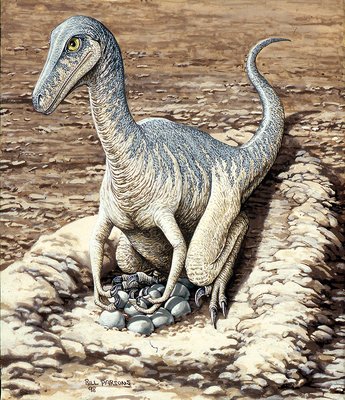
The males of three dinosaurs - _Troodon _(shown here), _Oviraptor _and _Citipati _ - appear to have sat on nests, like many birds today. Courtesy of Science
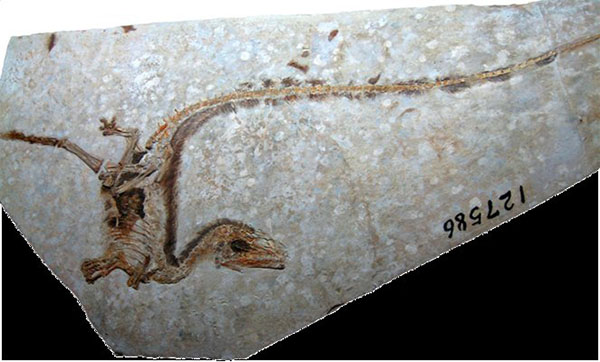
_Sinosauropteryx _fossil from Mongolia. Sam Ose, Creative Commons ShareAlike Attribution 3.0
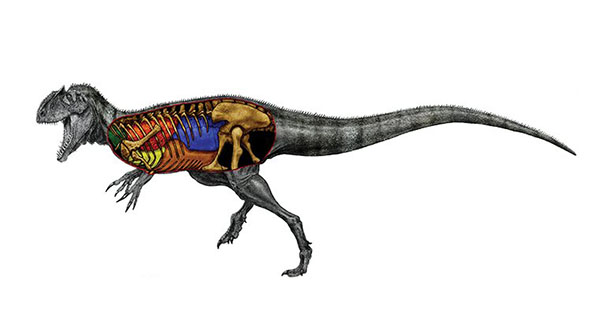
The skeleton of _Aerosteon riocoloradensis_ apparently contained air sacs in its wishbone and belly ribs, suggesting bird-like lungs. Drawing by Todd Marshall 2008, courtesy of Project Exploration
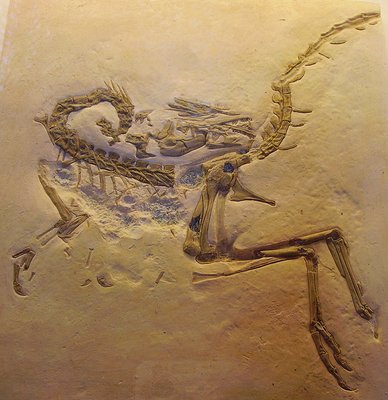
This _Compsognathus _skeleton was discovered in the 1850s in the same Solnhofen limestone that yielded _Archaeopteryx_. Ballista, Creative Commons ShareAlike Attribution 3.0
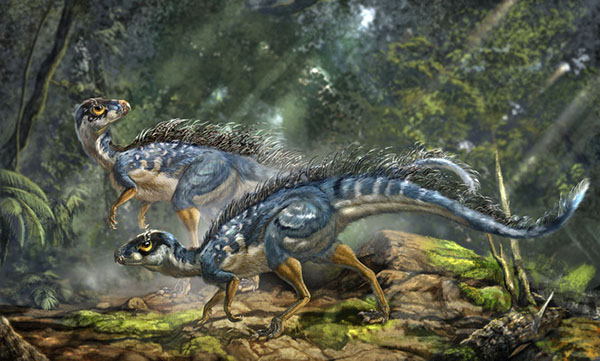
Bird-hipped_ Tianyulong confuciusi_ may have had "protofeathers." Li-Da Xing
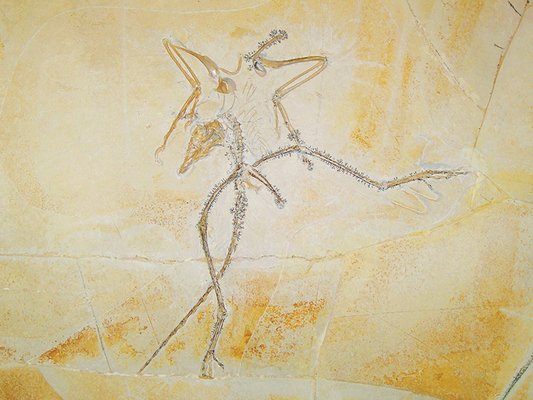
This _Archaeopteryx lithographica_ was discovered in the Solnhofen limestone of Bavaria, Germany. Stephen Schulz, Creative Commons ShareAlike Attribution 3.0
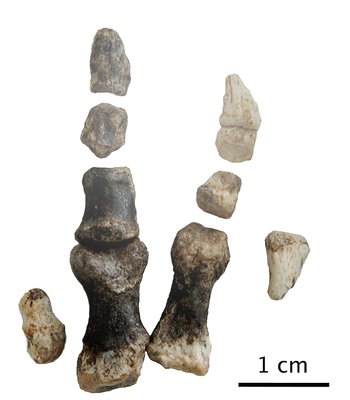
The hand of _Limusaurus inextricabilis_. Scientists say it shows a vestigial first finger as well as the developed second and third fingers. James Clark
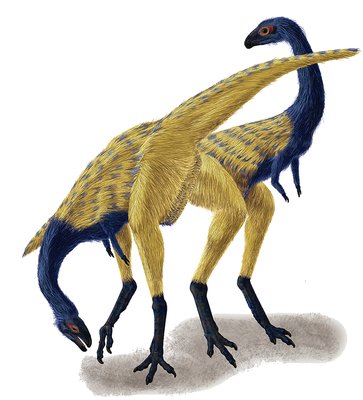
Artist's reconstruction of _Limusaurus inextricabilis_. Portia Sloan
In 1861, German paleontologist Christian Erich Hermann von Mayer excavated the fine-grained limestone layers of a quarry near Solnhofen, Germany. The 150-million-year-old limestone had already proven promising for finding fossils: A year earlier, von Mayer had found the imprint of a single feather preserved in the rock. But this time, he discovered something more spectacular: an entire skeleton of what appeared to be an ancient bird.
Charles Darwin described the creature, which was missing its head and neck, in the fourth edition (1866) of his book “On the Origin of Species”: “Until quite recently … some have maintained that the whole class of birds came suddenly into existence during the Eocene period … but now we know … that a bird certainly lived during the deposition of the upper greensand,” a term used at the time to describe a Cretaceous-aged green sandstone formation. Darwin went on: “That strange bird, the Archaeopteryx, with a long lizard-like tail, bearing a pair of feathers on each joint, and with its wings furnished with two free claws, has been discovered in the oolitic slates of Solnhofen.”
Following von Mayer’s discovery, scientists began to consider that dinosaurs — specifically theropods, bipedal dinosaurs that evolved during the Late Triassic about 230 million years ago — might be the ancestors of birds. Theropods, the group of dinosaurs that includes velociraptors and tyrannosaurs, had certain features in common with modern birds: three toes, a wishbone and air-filled spaces in their bones. And paleontologists continue to unearth fossil and morphological data — including hundreds of skeletal features, similarities in digestive systems and other internal systems, and possible feathered dinosaur fossils — that support this hypothesis.
One such powerful link came in 2005, when the details of a nearly complete skeleton of another Solnhofen-originating Archaeopteryx were published in Science. The new specimen was the best-preserved yet, revealing that Archaeopteryx lacked a modern bird’s first toe — the one that a bird uses to perch — but that it did have a hyperextendable second toe, similar to the menacing claw of a velociraptor. But many evolutionary puzzles remain: How did hands become wings? Did any dinosaurs have feathers? How did birds’ unusual, highly flight-specific respiratory systems evolve? Paleontological finds provide evidence both for and against dinosaurian ancestry — and each new dinosaur discovery only seems to further muddy the picture.
In 1996, scientists in China discovered Sinosauropteryx, an Early Cretaceous dinosaur from about 120 million years ago that bore a resemblance to the small, voracious “compys” (Compsognathus) portrayed in the movie “Jurassic Park.” The Sinosauropteryx fossils were remarkably well-preserved and appeared to show that the creature’s body was covered with faint, furry protofeathers, dubbed “dino-fuzz.”
China proved to have many more small, bipedal feathered dinosaurs dating to the Early Cretaceous: Sinornithosaurus millenii, discovered in 1999, showed traces of avian feather structures. In 2002, scientists announced the discovery of a dinosaur, named Microraptor gui, that lived about 125 million years ago and appeared to have feathers on both its front and hind limbs. Beipiaosaurus, a 125-million-year-old dinosaur discovery announced in January, was the first to show feather-like structures that had a single filament rather than multiple filaments — possibly showing the earliest example yet of feather evolution.
These discoveries seemed to provide a rough sketch of feather evolution in these theropod dinosaurs, supporting the idea that theropods might be the ancestors of today’s birds. Then, last March, scientists announced yet another small, bipedal Early Cretaceous dinosaur that may have had protofeathers, called Tianyulong confuciusi. But this time, there was a twist. Unlike the other discoveries, Tianyulong confuciusi was not a “lizard-hipped” theropod; instead, the new dinosaur was an ornithischian, described as “bird-hipped,” with a pelvis in which the pubis points backward (for example, Stegosaurus and Triceratops were both bird-hipped).
The terminology is misleading: Although this hip structure is somewhat similar to a bird’s, paleontologists have not considered the hip structure to be evidence of ancestry. Instead, ornithischians and birds likely evolved the backward-facing hip structure separately, in an example of convergent evolution. But the new evidence of dino-fuzz on a bird-hipped dinosaur ruffled feathers, suggesting that an ancestral relationship between dinosaurs and birds may be more complex than paleontologists had realized.
Feathered dinosaurs aren’t the only recent evidence that they may be birds’ ancestors; scientists have also found that some theropods may show traces of birds’ complex breathing structure. In September 2008, paleontologist David Varricchio of Montana State University in Bozeman reported in PLoS ONE that the skeleton of a large predatory dinosaur held pockets that may have contained bird-like air sacs. The dinosaur, called Aerosteon riocoloradensis, showed signs of the air sacs in its wishbone and ribs. And other researchers, Varricchio says, have found evidence of air sacs in other theropods.
“In our paper, we tried to take the approach that it’s a complex system in modern birds,” Varricchio says. “Not all dinosaurs [had] that system; but within theropods, as you move closer to birds, you get additions of more and more parts of the machine.” For example, the earliest theropods had only the cervical air sac, he says, but later theropods show signs of cranial, clavicular and abdominal air sacs as well. Another important aspect of birds’ breathing is the sternum and the ribs, which “act as a bellows-pump mechanism,” pushing air under pressure along a one-way path through the bird’s rigid lungs, Varricchio says. It’s a structure, he says, that only shows up in theropods that are close to the ancestry of birds.
Perhaps the most compelling — and controversial — evidence of the close ties between birds and theropods is found at the molecular level. In 2005, paleontologist Mary Schweitzer of North Carolina State University in Raleigh and colleagues described how they extracted soft tissue from a 68-million-year-old Tyrannosaurus rex fossilized leg bone. By 2007, Schweitzer and her team identified small fragments of collagen in the tissue. They compared protein sequences in the collagen with those of modern animals — and found the closest match to be modern chickens, strengthening the genetic link between dinosaurs and birds.
But for every argument, it seems there’s a counterargument. Not everyone thinks dinosaurs deserve a place in the bird family tree. Ornithologist Alan Feduccia of the University of North Carolina at Chapel Hill, for example, doubts the dino-fuzz: He sees skin and tissue where paleontologists see feathers. The numerous fossil imprints of protofeather filaments in Sinosauropteryx, for example, represent fibers of collagen, the primary structural protein in skin tissue, Feduccia and others wrote in a Journal of Morphology study published in 2005. Collagen is relatively tough, composed of inelastic fibers and relatively insoluble in water, making it more likely than other soft tissues to be preserved. Another strike against the idea that Sinosauropteryx represented a stage in feather evolution is that Archaeopteryx, about 30 million years older, could already fly, according to Feduccia.
Meanwhile, last June, zoologist Devon Quick and vertebrate paleobiologist John Ruben of Oregon State University in Corvallis published a paper in the Journal of Morphology that emphasizes the uniqueness of bird respiration — specifically the skeletal morphology related to avian breathing — and on that basis calls into question a theropod-bird ancestry.
A bird’s respiratory system stands in stark contrast to that of other animals, Quick says. Flying requires a lot of energy and oxygen. As a result, over time, birds have developed a highly efficient lung and respiratory system that allows them to take in enough oxygen and exchange carbon dioxide efficiently enough to allow them to fly. “The way they move air across their lungs is really different from the way we do it,” she says. “It’s very special. We use a diaphragm to change the volume of our lungs. They don’t change the volume at all, because they have these really specialized collapsible structures, really thin-walled, compliant air sacs.” Birds also have a special skeleton, Quick says, that keeps the air sac from collapsing when the bird inhales.
In the study, Quick and Ruben detailed new findings about this specialized skeleton, including an immobile thigh bone that is locked into the body wall and provides extra skeletal support for the birds' flabby air sac. But the more controversial news was the underlying implication: that if dinosaurs are the ancestors of birds, it seems unlikely that scientists would have found no trace of this highly specialized system in any dinosaur fossils.
“We’re suggesting that theropod dinosaurs did not have a bird-like lung,” Quick says. That, in turn, suggests that theropods may not be the ancestors of birds, she says, but instead may represent an extinct lineage. “I don’t think it’s clear what theropods are at all, as far as what they gave rise to or what gave rise to them.” One possibility, she says, is that theropods and birds might both be derived from a common ancestor.
The evolution of avian respiration is a tricky question, Varricchio says, because it’s a complex system that’s not likely to be preserved in the fossil record. “We’re really trying to predict what the lungs [of dinosaurs] look like, and they don’t leave any trace on any bone.” Even in birds, it’s not necessarily straightforward, he adds: For example, birds brooding on a clutch of eggs can’t use their sternums as a bellows — they have to use their abdominal muscles, suggesting that although the sternum is important, it may not be absolutely necessary for birds to breathe. Still, in their paper, Quick and Ruben do make a good point that the abdominal structure of most theropod dinosaurs is distinct from that of birds, Varricchio says. So, he adds, that structure is “probably not doing the exact same thing” when it comes to breathing.
Quick insists that she didn’t set out to disprove a bird-dinosaur link. “I just don’t think we have enough information to make a definitive conclusion,” she adds. “[It’s] the nature of the fossil record — it’s so spotty. While we can have some good preservation, we don’t have the whole picture to say that ‘x’ is really derived from ‘y.’”
Quite apart from questions of feathers and lungs is another puzzle: how a theropod’s hand might have evolved into a bird’s wing. The hand-to-wing transition is a big thorn in the side of the theropodbird evolutionary relationship. The longstanding debate centers on digits: Although early theropods had five digits, they appeared to lose two of them over time, so that later theropods had only three. Modern birds also have three “fingers” in their wings.
So far, so good. The sticking point, however, is that although both theropods and birds had three digits, they don’t seem to be the same three digits. Later theropods are missing the two outermost digits, or numbers four and five (equivalent in humans to the ring and pinky fingers). However, evidence from the embryos of developing birds suggests that their wings arise from digits two, three and four (so that they are, essentially, missing digits one and five — equivalent to the human thumb and the pinky).
That offset of digits has been a big enough problem that creationists have pointed to the issue as a way of discrediting evolutionary theory, says paleontologist James Clark of George Washington University in Washington, D.C. “More rationally,” he adds, “the developmental biologists have looked to say, ‘What’s really going on here?’” But to date, the possible explanations for why theropods and birds each have three fingers — but not the same three fingers — have lacked supporting evidence. One idea, Clark says, was a “frame shift,” in that the three bird fingers took on the shape of the three theropod fingers. “There was a lot of speculation about what happened,” he says, “but there wasn’t evidence from the fossils.”
But an intriguing new fossil may fill in some gaps. Clark and colleagues published a paper in Nature last June describing a 160-million-year-old dinosaur found in a Jurassic mud pit in China. “These animals had become mired in the mud — there’s evidence that they moved the sediment around and were struggling,” Clark says. He and his team discovered a number of fossils in this mud pit, he says — it became the subject of a National Geographic film titled “Dino Death Trap” — “but we hadn’t gotten a really good one, with a skull, until 2005.”
That year, the team found a nearly complete skeleton that was missing only the last half of its tail. “Once we saw the skull and arms of this thing, we were pretty sure it was something new,” Clark says. The creature, which they named Limusaurus inextricabilis (“mire lizard who could not escape”), had an unusual skull, with no teeth and a fully developed beak. It also had gizzard stones — something found in plant-eating chickens and turkeys, but not in carnivorous birds.
But the most interesting part of the new dinosaur was its hands: Limusaurus had four fingers, not three — and that, Clark says, suggests that it might represent a transitional theropod species. Next to its fully developed second, third and fourth fingers, Limusaurus had a tiny first digit. “It was reduced to a little nubbin, while the second digit had become this big robust finger,” Clark says.
The wrist bones, meanwhile, also indicate some complicated developmental shifts, Clark says. Limusaurus’ wrist bones were similar to bones associated with digits two, three and four, but the finger bones themselves resembled digits one, two and three. Overall, he says, the new dinosaur suggests that something transitional was occurring between the early theropods with five fingers and the later three-fingered theropods, such as allosaurs, which some scientists think gave rise to birds.
But not all paleontologists — even those who argue that birds are the descendants of theropod dinosaurs — are convinced that Limusaurus represents a missing link in hand-wing evolution, or that finding such a missing link is even necessary to prove the point. In fact, says Kevin Padian, a paleontologist at the University of California at Berkeley, the whole question of wing digits may be something of a straw man argument.
“Developmental biologists really don’t know what they’re looking at when they see the digits develop in a bird,” Padian says. “They just put arbitrary numbers on them. For some reason, the authors think they have to reconcile an imaginary model that the bird fingers are two, three and four with the knowledge that as dinosaurs reduced their fingers, they lost four and five and wound up with one, two and three, which is what birds retain.” As for Limusaurus, Padian says, “this seems to be just an ordinary theropod with some unusually reduced digits. That’s not odd — lots of animals have weird fingers. But we don’t use the weird ones to try to overthrow everything we know about how the fingers became reduced in dinosaurs.”
So, are birds modern dinosaurs? The debate still continues. Ornithologist Feduccia’s opposition to a dinosaurian ancestry for birds has become well-known. Some of his concern, he says, is that the link is so tenuous that it invites opposition from creationists, who point to any holes in the evolutionary link between birds and dinosaurs or disputes over evidence that dinosaurs were feathered as evidence against evolution. “We all agree that birds and dinosaurs had some reptilian ancestors in common,” Feduccia told the University of North Carolina’s Chapel Hill news service in 2005. “But to say dinosaurs were the ancestors of the modern birds we see flying around outside today because we would like them to be is a big mistake.” Varricchio, however, frames the question differently. “Sometimes people simplify things and say that if birds do it, then dinosaurs must do it,” he says.
“But dinosaurs are really diverse — they lived for 165 million years, not counting birds. They had different body shapes and likely did all kinds of different things. There’s great variety and no reason a T. rex or another dinosaur should necessarily have the same apparatus. But that doesn’t mean they couldn’t give rise to birds.”
© 2008-2021. All rights reserved. Any copying, redistribution or retransmission of any of the contents of this service without the expressed written permission of the American Geosciences Institute is expressly prohibited. Click here for all copyright requests.